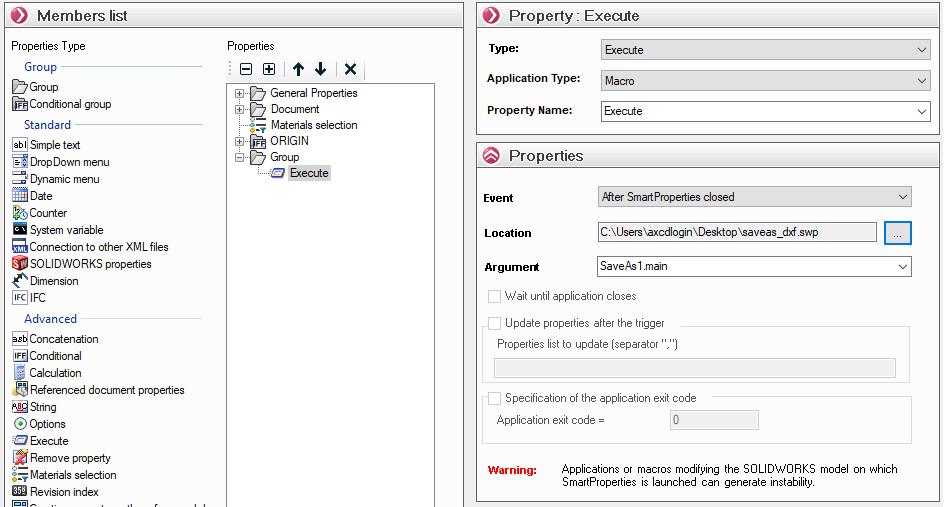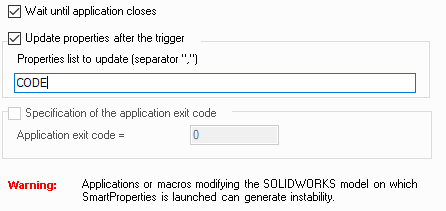Run
Drag and drop the '' icon to the right.Run'' to the desired position in the column ''.Properties''. Or ''Double click'' on the icon ''.Run''.
This type of property is used to launch an application or macro based on an event (button, opening or validation of SmartProperties).
 The '' typeRunSmartProperties'' is designed for advanced users who have a basic understanding of application development. These applications can be run with SmartProperties.
The '' typeRunSmartProperties'' is designed for advanced users who have a basic understanding of application development. These applications can be run with SmartProperties.

The application type is set by selecting it from the drop-down menu.

Three types are available:
''Application'' - a program (.exe) will be executed
''Macro'' - a macro function (.swp) will be executed
''Website'' - a link will open a web page to access a website.
In the "Properties" area, we'll find the parameters linked to this action.
- Triggering :

-> ''Button'' - indicates that the action will be triggered by pressing a named button.
-> ''At the launch of SmartProperties'' - indicates that the action will be triggered as soon as the SmartProperties utility is launched.
-> ''SmartProperties validation'' - indicates that the action will be triggered as soon as validate is pressed  .
.
-> ''After closing SmartProperties'' - indicates that the action will be triggered as soon as you exit the SmartProperties utility. In fact, you can validate the information by pressing  but if the window has been pinned
but if the window has been pinned  then this action will not be taken into account.
then this action will not be taken into account.
-> ''During specification testing'' - indicates that the action will be triggered while the utility takes into account the parameters defined in the '' field.Specifications''. Before creating properties. This can be used to add custom specifications using the '' option.Specifying application output code''.
-> ''Before creating an input mask'' - indicates that the action will be triggered before analyzing the properties already existing in the file and displaying the SmartProperties input mask in the PropertyManager.
- Location:
Here you determine the location and application (macro or executable) by pressing  which will trigger the action.
which will trigger the action.
- Argument:
-> For a macro, this parameter is filled in automatically; it's generally the macro's entry point.
-> For an executable application, this is where you specify the parameters to be passed at the start of the program. To declare variables used in the program, precede the name with the '' character.$''.
Once this information has been entered, it is still possible to modify certain options.

''Wait for the application to finish before handing over to SmartProperties'' - indicates that as long as the application is running, the SmartProperties utility is suspended, and will not take over until the program has finished. This option is not available for macro execution, so it will be grayed out.
''Update properties after triggering'' - allows you to update the value of properties (specified in the list) in the SmartProperties input mask after program execution. In the case of several properties, the separator used will be the ''.,''.
''Specifying application output code'' - used only with '' triggerDuring specification testing'', is used to add a specification. If the application's output code is different from the code entered in SmartProperties, then the properties are not created. In your application, use the '' apiEnvironment.Exitto return the application's output code.
